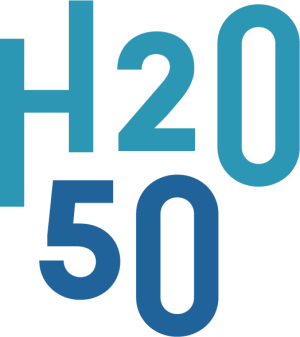“Domestically sourced water’ represents unquestionable quality, with an identity.
Watermark revisited
Tap water producers and bottled water producers share the same goal: to bring pleasant-tasting and affordable drinking water to the public. Their model varies, but their raw material, water, turns out to be finite. So it is not certain whether both models can continue to co-exist, without putting pressure on each other. Pressure that is already being felt. Sometimes resulting, for instance, in unclear and contradictory information for consumers and a decline in the image of tap water. This image is part of what we call the ‘symbolic capital’ of water. For example, drinking water is strongly associated with a healthy lifestyle. Taking water to work doesn’t necessarily mean you are healthy, yet you can earn some kudos by associating yourself with it. In the same way an expensive car is supposed to convey success. That is symbolic capital, and we find elements of it in the image of water.
The positioning of drinking water producers is very strongly based on that image. Some bottled water producers will claim that their water is not chemically treated, with the underlying message that chemically treated water is not really ideal. Tap water producers will claim that tap water undergoes more tests than bottled water. This battle for image risks undermining consumer confidence. Experts reassure us that tap water or treated waste water is perfectly safe. However, these days the public in Flanders has significant reservations.
Up until now, the question of drinking water has been very straightforward. You either chose bottled water from a natural source, or you drank water from the tap. The classic image in the minds of many consumers. The development of technology for decentralised water production, the growing awareness of micro-plastics, the growing range of applications ‘for the tap’ (auxiliary filters or built-in filters, rapid cooking systems, etc.), these are all evolutions that gradually hollow out and broaden the simple dichotomy between tap water and bottled water.
What’s more, bottled water producers are already being confronted with water scarcity, and they too are forced to admit that they are not the only ones with claims on the water supply. For example, The Daily Telegraph reported in 2018 that there was already a conflict between the city council of Vittel and the company of the same name, when the city faced water shortages and accused the company of overexploiting water resources. All these increasing ‘pressures’ from different sides seem to be redrawing the landscape of drinking water production and sales, which will be a difficult issue without consumer confidence.
Moreover, beneath the battle for image there is another layer of deeper and therefore more systemic causes. For example, the reason that tap water is rigorously tested is because of the higher vulnerability of tap water compared to bottled water. Protecting the drinking water network against pollution is one of the biggest challenges for tap water companies. A challenge that will continue to grow in the future, when alternative water sources will have to be used for our (drinking) water supply.
People are therefore thinking about how water consumption can be scaled back, but also about how we can reuse water. In addition, there are various reflections on an alternative ‘parcelling’ of the water supply chain, with one possible option being a water network that does not supply drinking water quality, but water that is then upgraded at the end of the supply chain. A good example of this is DC Water and Bosaq, who offer personalised water services that are offered to the customer ‘after the meter’ such as smart leak detection, variably controlled water demand, personalised flavouring, additives, etc. A tap water supplier who ‘retreats’ a little could therefore create space for innovation and entrepreneurship. But that raises new questions about inclusiveness, affordability, ethical issues, and so on. Exploring these kinds of avenues in co-creation can create powerful openings to examine bottled water production, tap water and circular production and end chain in a synergistic and future-proof context. Implementing a reflection exercise based on a customer journey could bring clarity in this regard.
Who will set up a Customer Journey to map out the complete process between consumer and product? This relates to both direct contacts between the consumer and the water company as well as indirect contacts, such as opinions of others via social media, blogs and reviews. As such, we provide insight into the customer experience, in order to improve the image of drinking water. We redesign value chains based on these insights, and look for opportunities to bring together value models, technology and image enhancement into a model that strengthens Flemish Water Capital.
Download all catalysts
Disclaimer
The Flemish Environment Agency (VMM), De Vlaamse Waterweg, De Watergroep, Aquafin, the Flemish Department of Environment, Farys, Pidpa, water-link and VITO - Vlakwa have created the space for a group of fresh thinkers to develop a systemic view of water, and to challenge the water sector to shape a futureproof water system. The formulated ideas are not those of the initiators, nor do they represent their stands. However, they are considered valuable as an inspiration for the future of our water system.
This work is licensed under a Creative Commons Attribution 4.0 International License.
